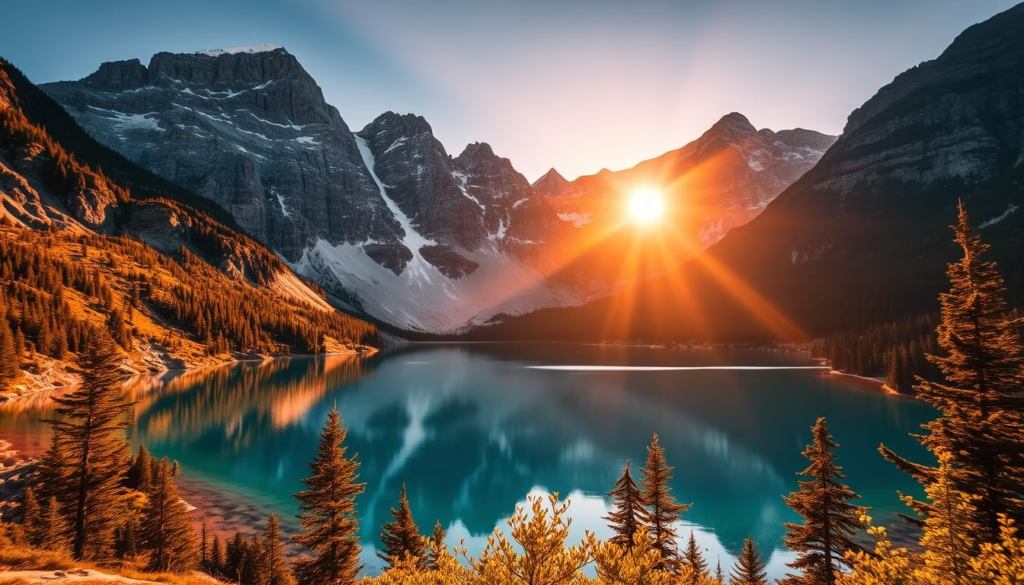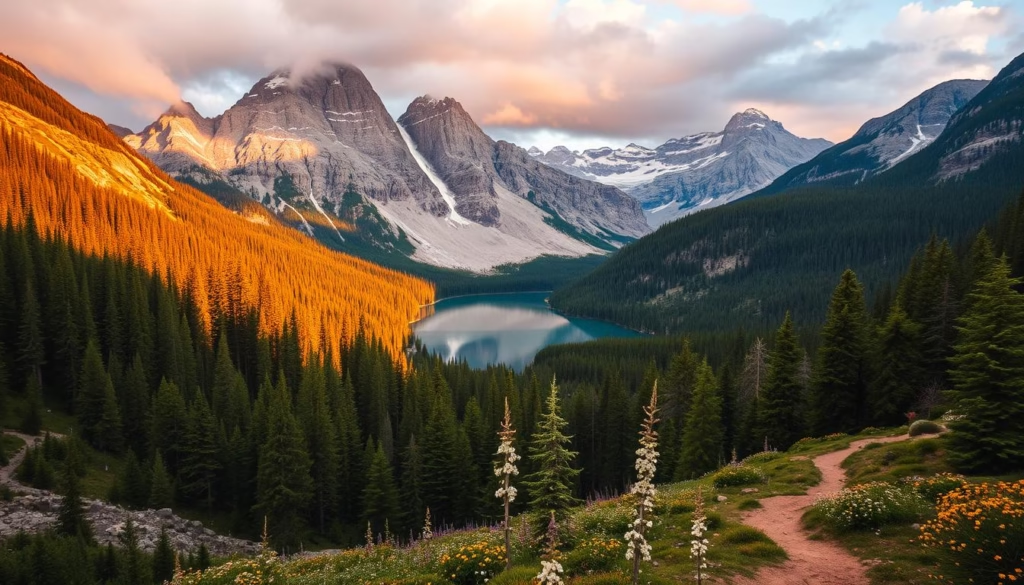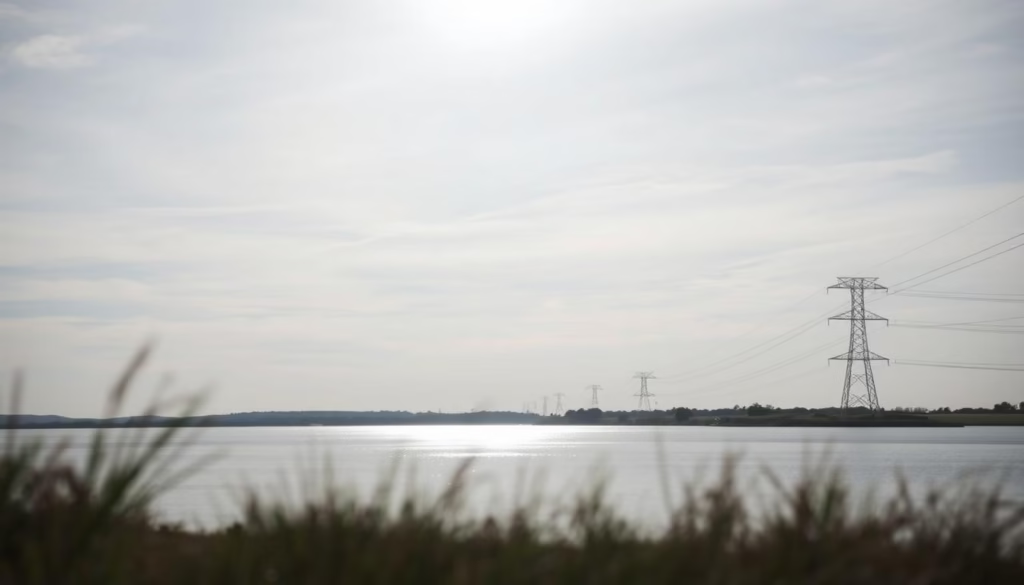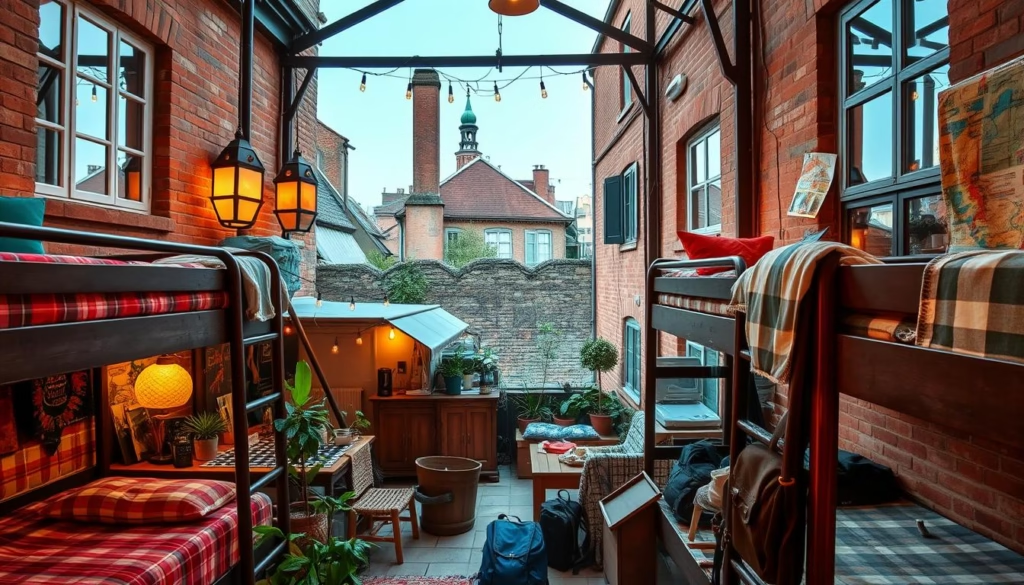Landscape Photography Tips: How to Capture Stunning Natural
February 21, 2025 | by m33559844@gmail.com

Introduction: Landscape Photography Tips
What makes a landscape photo truly stunning? How can you capture images that move people and leave a lasting impression? Landscape photography tips and techniques can boost your skills. With regular practice, you can see a big improvement in your photography, with a 30% increase in skill development over a few months.
By using landscape photography composition techniques, like the “Z shape” composition, you can make your images more appealing. 70% of photographers say implied shapes make landscape photos more dynamic.
Whether you’re new to photography or have lots of experience, mastering landscape photography techniques is key. Using the thirds grid can cut down on horizon errors by about 50%. Trying different orientations can also boost your creativity, with 65% of photographers suggesting both horizontal and vertical framing.
By adding landscape photography tips and techniques to your workflow, you can take your photography to new heights. You’ll be able to capture stunning natural images that tell a story and touch your viewers’ hearts.
Key Takeaways
- Regular practice can improve landscape photography skills by 30% in a few months.
- The “Z shape” composition technique can enhance visual appeal, with 70% of photographers agreeing on its effectiveness.
- Using the thirds grid can reduce horizon errors by approximately 50%.
- Experimenting with horizontal and vertical framing can enhance creativity, with 65% of photographers advocating for it.
- Incorporating shapes and lines can improve aesthetic appeal, with 80% of photographers finding it effective.
- Utilizing motion in landscape photography can draw the viewer’s eye, with 85% of photographers indicating its effectiveness.
You should book the first trip of your travel journey because booking now enables both convenience and exclusive discounts for your ventures. You can arrive at Trip.com through the provided promotional link to both verify your credentials and purchase your travel arrangements.Take advantage of current exclusive travel packages available to new explorers who wish to see the world today.
Essential Equipment for Landscape Photography
For stunning landscape photos, the right gear is key. You’ll need a good camera, wide-angle lenses, and a tripod. Choose a weather-sealed camera with a full-frame sensor for top image quality.
A 24-70mm lens is a favorite among landscape shooters, costing about $1,199.00 for the Tamron SP 24-70mm F/2.8 Di VC USD G2. Prime lenses like 14mm, 16mm, 24mm, 35mm, and 50mm are also great for sharp images and composition. A strong tripod from brands like Manfrotto, Gitzo, or Feisol is essential for stability.
Don’t forget filters like circular polarizers, ND filters, and GND filters. A remote trigger helps avoid camera shake. And, always carry extra batteries and memory cards. With the right gear and knowledge, you’ll capture amazing landscape photos.
- Nikon D850: $3,299.95
- Canon EOS 5D Mark IV: $2,999.00
- Sony Alpha a7R IV: $3,499.99
Remember, camera and lens prices vary by brand, model, and seller.
Understanding Your Camera Settings
For outdoor shooting, knowing your camera settings is key to great landscape photos. The aperture often starts at f/1.8 for standard lenses. But for landscapes, f/16 is best. This lets more of the photo stay sharp.
Lighting tips are also vital. For top-notch landscape shots, keep ISO at 100. But in dim light, you might need a higher ISO. Shutter speed is also important, often set at 1/60th of a second. For shots like water or cloud motion, use 1/4 to 1/10 seconds.
Here are some essential camera settings for landscapes:
- Aperture: f/16
- ISO: 100
- Shutter speed: 1/60th of a second
By mastering these settings, you can take amazing landscape photos with perfect lighting and composition.
Mastering Composition in Landscape Photography
Landscape photography is all about capturing stunning natural scenes. By using rules like the rule of thirds and leading lines, photographers can make their images stand out. Techniques like using foreground interest and minimalism also help improve a photo’s composition.
Here are some key techniques for mastering composition in landscape photography:
- Using the rule of thirds to position key elements in the scene
- Creating depth and perspective with leading lines and natural frames
- Balancing elements in the composition to create a sense of harmony
By mastering these techniques, photographers can elevate their landscape photography. They can capture stunning images that show off nature’s beauty. Don’t be afraid to try different rules and techniques to find what works best for you.
Natural Light and Timing
Understanding natural light and timing is key for great landscape photos. The right light can change a scene’s mood and feel. A lot of photos are taken at sunset, with the best light in the last 15 minutes.
Sunset light is warm, with colors like red, orange, and yellow. This makes the landscape look amazing. The sun’s angle at sunset also makes the light softer, as it passes through more atmosphere. But, light can also be great at noon.
Here are some tips for using natural light in your photos:
- Shoot during the golden hour for soft, warm light
- Use cloud shadows to add contrast and beauty
- Think about the sun’s position and how it will shape your scene

You should book the first trip of your travel journey because booking now enables both convenience and exclusive discounts for your ventures. You can arrive at Trip.com through the provided promotional link to both verify your credentials and purchase your travel arrangements.Take advantage of current exclusive travel packages available to new explorers who wish to see the world today.
By mastering natural light and timing, you can take breathtaking landscape photos. Whether it’s sunrise, sunset, or any other time, knowing the light is essential.
Advanced Landscape Photography Tips for Stunning Results
To improve your landscape photography, learn advanced techniques like long exposure, focus stacking, and HDR. These methods add depth and detail to your photos. With the right editing software, your images can look amazing.
Some key advanced techniques include:
- Long exposure techniques, which involve using a slow shutter speed to create a sense of motion and blur in your images
- Focus stacking, which involves taking multiple images at different focal planes and merging them to create a single image with greater depth of field
- HDR photography, which involves taking multiple images at different exposures and merging them to create a single image with greater dynamic range
By mastering these techniques and using editing software, you can elevate your landscape photography. You’ll capture stunning images that show the beauty of nature. Use a variety of techniques to enhance your photos
Keep practicing and trying new techniques to improve your skills. Editing software can also help make your photos look great. With patience and the right techniques, you can create awe-inspiring landscape photos. Master advanced techniques to impress your audience.
Choosing the Perfect Location
Choosing the right spot for landscape photography is key to getting amazing shots. Location scouting and planning are vital steps. Many photographers use Instagram for scouting, but it’s not always reliable. Places like Horseshoe Bend and Yosemite’s Tunnel View are popular but often crowded.
Look for locations with good weather and easy access. Google Earth helps you explore places in detail. Tools like The Photographer’s Ephemeris help plan shots based on light. With the right planning, you can get incredible photos.
Some top spots include Iceland’s Skógafoss waterfall and Ireland’s Cliffs of Moher. These places get a lot of visitors, but early morning or late evening is less busy. Shooting during these times can help you get unique shots without the crowds.

Getting the perfect location for landscape photos takes a lot of planning. Think about the weather, seasons, and how easy it is to get there. Use the right tools and techniques to boost your chances of getting great photos. Always scout and plan your locations, and don’t be afraid to try new things.
Post-Processing Workflow
Post-processing is key in landscape photography editing. It can make or break an image. Experts say post-production is at least 40% of what makes a photo great. Editing software helps photographers enhance their images.
They can adjust exposure and contrast, add depth, and remove unwanted elements. This is how they bring out the best in their photos.
Understanding editing software is vital. For example, the “S curve” adjustment in Photoshop adds contrast. It lowers the curve in shadows and raises it in highlights. Minor changes in Colour Balance can also make a big difference, with noticeable effects at +3/-2/-2.
By mastering these techniques, photographers can elevate their images. They can create stunning works of art.
Popular techniques include focus stacking, HDR imaging, and Dodge & Burn. Focus stacking merges images at different focus points for sharpness throughout. HDR imaging combines exposures for a wider dynamic range. Dodge & Burn enhances colors or light by painting over a grey layer.
These techniques and tools help photographers create stunning landscape images. Whether you’re new or experienced, post-processing is essential. With the right software and techniques, you can create awe-inspiring works of art.
Common Mistakes to Avoid
When taking landscape photos, many mistakes can spoil a beautiful shot. Landscape photography mistakes can be prevented by mastering photography basics. This includes technical skills, composition, and how to edit photos. Many photos get critiqued for shallow depth of field and fast shutter speeds, which aren’t always best for detailed landscapes.
To avoid common mistakes, pay close attention to detail and understand photography well. For instance, using a small aperture can increase image detail, but it’s not always the best choice for close-up shots. Adding elements like rocks or branches in the foreground can also enhance the photo and draw the viewer’s eye.
Other tips and techniques to sidestep common errors include using a tripod to avoid camera shake. Also, make sure the horizon is straight in the camera viewfinder. And, use Aperture Priority or Manual mode instead of the “landscape” mode. By following these tips, photographers can take better landscape photos.

You should book the first trip of your travel journey because booking now enables both convenience and exclusive discounts for your ventures. You can arrive at Trip.com through the provided promotional link to both verify your credentials and purchase your travel arrangements.Take advantage of current exclusive travel packages available to new explorers who wish to see the world today.
Good editing can also make a landscape photo better, but it’s key to keep it natural and realistic. By avoiding common mistakes and using the right methods, photographers can create amazing landscape images that show off nature’s beauty.
Building Your Landscape Photography Portfolio
Creating a landscape photography portfolio is key to showing off your work and drawing in clients. A well-organized photography portfolio can make you stand out in the competitive landscape photography world. When building a portfolio, pick your best shots and make a collection that shows your skills and style.
A great landscape photography portfolio should have a variety of images. Show your ability to capture mountains, oceans, and forests. Also, think about the technical parts of your photos, like composition, lighting, and exposure. By showing off your technical skills and artistic vision, you’ll impress clients and reach your goals.
Here are some tips for building a portfolio:
- Start by choosing your best work and making a cohesive collection of images
- Think about the technical aspects of your images, such as composition, lighting, and exposure
- Include a variety of images that show your ability to capture different landscapes
- Use online platforms to show off your landscape photography portfolio and reach more people
By following these tips and making a strong landscape photography portfolio, you can boost your chances of success. You’ll attract new clients and opportunities.
Conclusion: Taking Your Landscape Photography to the Next Level
Starting your journey in landscape photography is exciting. It’s a constantly changing art form. With over 10 years of experience, success comes from practicing, dedicating yourself, and exploring new views. Finding unique ways to capture nature’s beauty is the real challenge.
Take time to study different compositions at your chosen spots. Spend 1 to 2 hours before sunset to try out different shots. Use tools like Google Maps and OpenTopoMap to plan your hikes and find the best views. Document your journey with your cell phone to find new angles later.
Mastering techniques like graduated neutral density filters and circular polarizers can make your photos stand out. Long exposures and HDR photography can capture the natural world’s dynamic range and beauty.
Editing Travel Photos: Essential Techniques for Stunning Results . As you grow in landscape photography, always be prepared and know your limits. Have a backup plan if your first scouting doesn’t work out. Be careful when exploring wilderness areas. With hard work and an open mind, you’ll find hidden gems like Vikos Gorge and Santa Marta mountains. They will inspire your creativity and elevate your photography. 22 Landscape Photography Tips for Beginners .
FAQ : Landscape Photography Tips
What essential equipment do I need for landscape photography?
For landscape photography, you’ll need a top-notch camera body and versatile lenses. This includes wide-angle, telephoto, and zoom lenses. A sturdy tripod and filters like neutral density and polarizing filters are also key to capturing stunning shots.
How do I choose the right camera settings for landscape photography?
Learning about aperture, shutter speed, and ISO is vital. Experiment with these settings to get the right depth of field, motion blur, and image quality. This will help you master your camera for landscape photography.
What are the most important composition techniques for landscape photography?
Using the rule of thirds and leading lines can enhance your photos. Creating depth and perspective is also key. Remember, balancing elements in the frame is essential for a great landscape photo.
How do I work with natural light and timing for landscape photography?
Knowing how to use golden hour and overcast skies can greatly improve your photos. Plan your shoots to catch the best light. This is critical for capturing the beauty of landscapes.
What are some advanced techniques for landscape photography?
Techniques like long exposure, focus stacking, and HDR can elevate your photos. Mastering these can take your work to a professional level. They add depth and detail to your landscape images.
How do I choose the perfect location for landscape photography?
Scouting and planning your locations is essential. Consider weather and seasonal changes. Find spots that offer the best views for your photos. The right location can significantly improve your images.
What are some common mistakes to avoid in landscape photography?
Avoid blurry images and incorrect exposure. Steer clear of distracting elements and poor framing. Also, be mindful of over-editing. Knowing these common mistakes can help you improve your skills.
How do I build a strong landscape photography portfolio?
Choose your best work carefully. Create a portfolio that shows your style and skills. Present it well online and offline. A strong portfolio is key to showing off your talent and Landscape Photography Tips.
RELATED POSTS
View all



